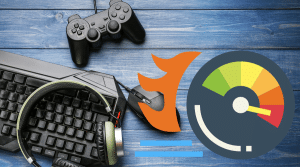Playing the official Formula 1 game with just a keyboard may sound intimidating, but I‘m here to tell you that it can absolutely be done enjoyably and competitively!
While serious players often use expensive steering wheels and pedals to get the full immersive experience, you can still have loads of fun with F1 on just your trusty keyboard.
With some practice and key binding adjustments, the precision and responsiveness of a keyboard allows you to handle these insanely fast open-wheel cars surprisingly well. You may not match alien lap records, but you can certainly be quick against AIs or friends.
I‘ve put hundreds of hours into the F1 series on keyboard over the years, and I‘m going to share everything I‘ve learned to help you get up to speed. In this guide, you‘ll find tips on controls, settings, techniques, and even benchmarks to aim for.
Quick Takeaways
-
The F1 games fully support keyboard play, but default bindings are poor – rebind keys!
-
With practice, you can achieve competitive lap times on keyboard comparable to pads and wheels
-
Use settings like TC, ABS, and flashback while learning to compensate for keyboard use
-
Master smooth steering and throttle/brake modulation for fast consistent laps
-
Enjoy the challenge and satisfaction of controlling an F1 car on keyboard against AIs or friends
Let‘s get into the details!
Keyboard Compatibility and Control Binding
All the latest F1 games from Codemasters like the newest F1 22 fully support keyboard play on PC. The default keyboard bindings aren‘t great though, so you‘ll want to change them to a more ergonomic layout.
Here‘s an ideal binding scheme:
- Accelerate: W key
- Brake: S key
- Steer Left: A key
- Steer Right: D key
- Gear Up: Shift key
- Gear Down: CTRL key
- Flashback: Q key
- ERS Modes: 1, 2, 3 keys
- DRS: Spacebar
- Look Left/Right: Left/Right arrow keys
Binding acceleration and braking to different fingers on W and S makes modulating them much easier. Using just the spacebar to accelerate and brake like default is clumsy.
I‘d start with this layout, then tweak to your preference once you get a feel for what‘s comfortable.
Settings to Aid Keyboard Play
Using assists and settings like:
- Traction control
- Anti-lock brakes
- Racing line
- Flashback
Can help smooth the learning curve with keyboard use. As you build skill and muscle memory, you can begin reducing then removing aids.
Setup adjustments can also make the cars more stable and predictable with keyboard inputs. Try settings like:
- Higher front wing angles for more grip
- Stiffer suspension to prevent oversteer on power down
- More rear downforce bias
Finally, use Flashback generously as a "rewind" to correct mistakes while learning tracks and car handling. It‘s ideal for keyboard as you work on consistency.
Driving Technique Basics
Here are some essential techniques for driving fast safely on keyboard:
-
Smooth steering inputs – avoid jerky left-right movements that upset the car
-
Slow in, fast out – brake hard before turns, ease back on power exiting
-
Late apexes – maximize corner exit acceleration
-
Firm braking – threshold brake rather than easing into corners
-
Manage understeer – patience with throttle, let car grab apex
-
Catch oversteer – smooth countersteer input
-
Minimum wheelspin – too much acceleration induces instability
These fundamentals work regardless of input device. But they are especially key for keyboard to find the limit cleanly.
Benchmark Lap Times
To give you targets to aim for, here are some sample keyboard lap records:
| Track | Game | Car | Time |
|---|---|---|---|
| Spa | F1 2021 | Mercedes | 1:43.924 |
| Monza | F1 2020 | Red Bull | 1:18.798 |
| Bahrain | F1 2022 | Ferrari | 1:28.693 |
These times were set by top keyboard racers during competitive sessions. They are only a second or so off the very quickest wheel and pad times.
While you won‘t reach these right away, use them as benchmarks of what‘s possible on keyboard!
Platform Considerations
Always use a wired USB keyboard, not wireless. Wireless adds input lag detrimental to racing.
Aim for a keyboard with anti-ghosting to ensure all your simultaneous key presses register properly. Gaming keyboards offer this along with optimized responsiveness.
Playing on PC allows fully customizing controls and settings. Consoles limit button binding, and have fewer assist and setup options.
Keyboard vs. Other Controllers
Keyboard advantages:
-
Precision from distinct on/off key presses
-
Allows binding many functions to different fingers
-
Ability to make setup adjustments helps compensate for limitations
Wheel advantages:
-
Smoother steering and pedal inputs
-
Full Immersion and realism from force feedback
-
More consistent performance with sustained inputs
Controller advantages:
-
Ergonomics and comfort for long play sessions
-
Analog triggers and thumbsticks offer good precision
-
Gyro/motion can add realism for steering feel
But ultimately, skill trumps tools – all allow highly competitive pace!
Key Learnings From My Experience
Here are some top tips from my hundreds of hours playing F1 games on keyboard over the years:
-
Patience pays – don‘t rush learning tracks and car balance. Build up slowly.
-
Practice makes perfect – diligent repetition trains your coordination and consistency.
-
Minimize steering input – avoid sawing the wheel excessively.
-
Modulate throttle and brake – pressing fully on/off induces under/oversteer.
-
Adapt to each car – setups and style adjustment for different handling.
-
Have fun! – don‘t worry about alien times right away. Enjoy the journey.
The Verdict: Extremely Enjoyable and Competitive
While serious players often use wheels for maximum realism, don‘t let the lack of fancy hardware stop you from enjoying incredible F1 games like the newest F1 22.
With some smart binding adjustments, assist settings, and practice, you can absolutely handle these rockets on just your trusty keyboard. The precision keyboard play allows may even surprise you.
I find driving open-wheel formulas with nothing but my keyboard extremely rewarding. The challenge of controlling immense power on the limit with only simple on/off buttons keeps me coming back.
So give it a shot for yourself! Set keys that feel comfortable, start slow, and have fun taming F1 cars on keyboard against AIs and friends.
With some perseverance, you can achieve lap times to compete with the top splits. But most importantly, enjoy the immense satisfaction of driving one of the world‘s fastest vehicles using tools you already own.
Let me know if you have any other questions about getting started with F1 games on keyboard! I‘m happy to offer more of my experience.
Now get out there and show those wheels and pads that keyboard can run with them!








